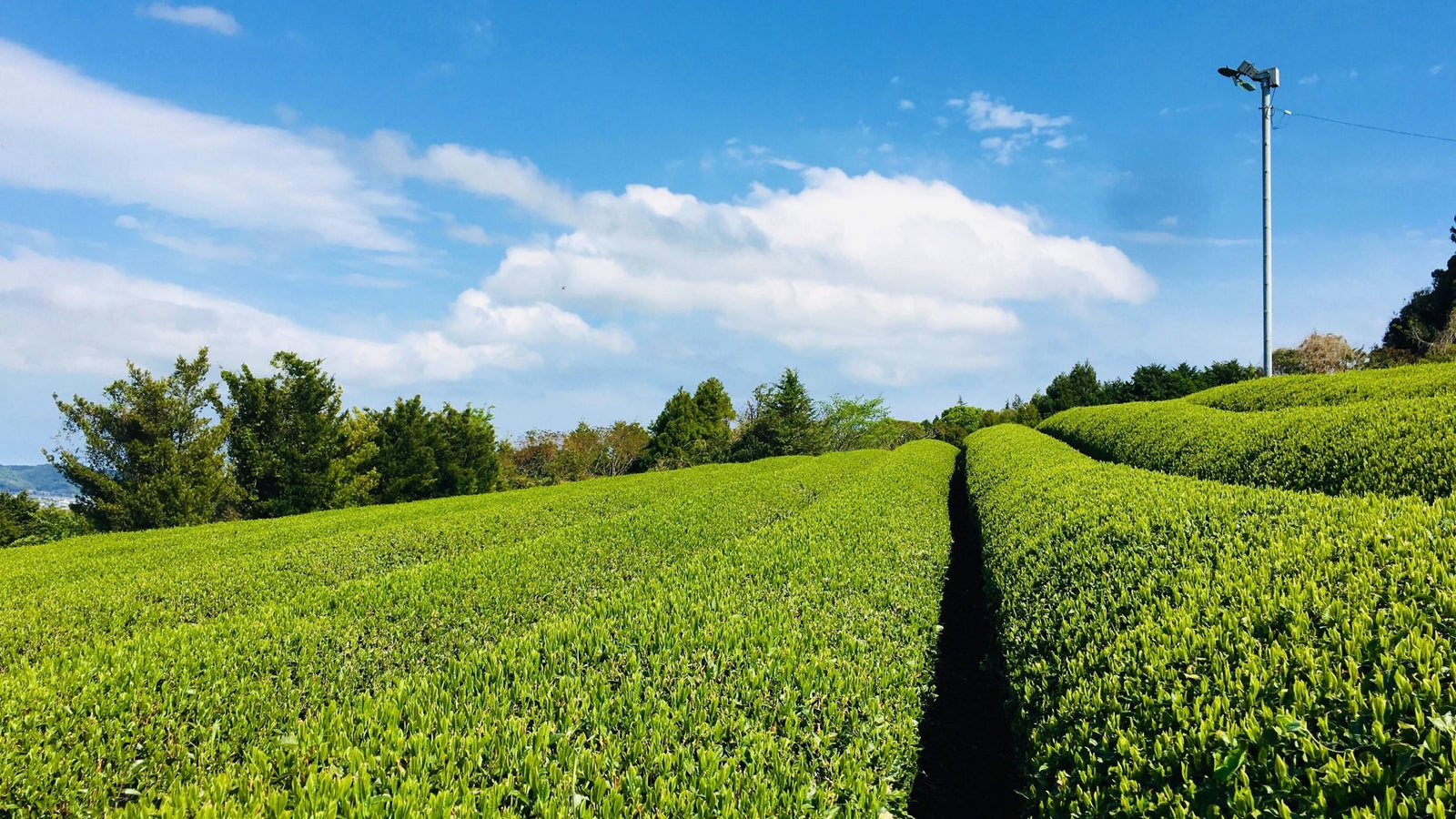このブログ投稿は、植物科学の博士号を持ち、お茶の愛好家でもあるジミー・バーリッジ氏(ゲスト)によって執筆されました。バーリッジ氏はお茶の農学、化学、テロワールの交わる領域に関心が高まっています(科学的な部分がわかりにくいのは彼のせいです!)。
気候変動は、特定の場所のお茶の独特の風味、つまりテロワールに影響を及ぼす可能性があります [1]。これは、お茶の香りと味の特徴が、茶の木が環境条件に応じて生成する数十種類の化合物によって決まるためです [2]、[3]。最高気温と最低気温の変化、1日または1年間の気温パターン、降雨量と分布、雑草や昆虫の圧力の変化はすべて、高級茶に特徴的なうま味と渋みのバランスを与える二次代謝産物、フェノール化合物、クロロフィル含有量の微妙なバランスに影響を及ぼす可能性があります。霧や雲は茶を強い日光から守りますが、強い日光は茶の木が自分を守るために使用する保護化学物質のバランスに影響を与え、微妙な風味と香りの変化をもたらす可能性があります。
以前の記事で、宇治の茶農家が気候変動を観察し、遮光方法の一部を変えることで対応していることを紹介しました。あゆみファーム( Cyittorattu )のような多くの有機農家は、麦わらマルチや醤油、日本酒、味噌の製造工程で発生する廃棄物を畑に散布しています。これらの資材は土壌の炭素含有量を高め、気温や降水量の変動を緩和する土壌の能力を高めています。先日、 ヤギを使って雑草の防除を行っている農家(静岡県の樽井ファーム)を取り上げました。今日は、環境条件が茶の科学者が「機能的品質」と呼ぶものにどのように影響するかについて、いくつか詳しく説明します。
 京都府和束村の丘陵地帯にある和束茶農家の西山さんが、茶畑を視察している。写真はジミー・バーリッジ撮影。
京都府和束村の丘陵地帯にある和束茶農家の西山さんが、茶畑を視察している。写真はジミー・バーリッジ撮影。
これまでのところ、気候変動が日本の多くの茶農家に及ぼす影響は、気温が文字通り茶の木にダメージを与えるほど高くなるインドなどの地域ほど深刻ではありません。一部の日本の農家は、生育期間の延長や茶の収穫量の増加という点で実際にプラスの影響を感じています。しかし、質と量の間にはトレードオフがあるかもしれません。まず、単純希釈効果の証拠があり、生育が過度に旺盛な場合、テアニン、カテキン、メチルキサンチンなど、良い風味に関連する二次代謝産物が相対的に少なくなるため、生産された茶の風味が薄くなることを意味し[4] 。これは、一般的に土壌の利用可能な総養分が少なく、成長が遅い傾向がある有機栽培の茶がより良い風味を持つ理由の一部である可能性があります。
 ジミーさんは秋の収穫期に和束茶農家の手伝いをしています。写真は岸田萌さんによるものです。
ジミーさんは秋の収穫期に和束茶農家の手伝いをしています。写真は岸田萌さんによるものです。
また、茶葉中の化学物質、特にポリフェノールとアミノ酸の比率が変化し、お茶の風味、香りおよび「機能的品質」に悪影響を与える条件もあります[5] 。広い化学的観点から言えば、アミノ酸、主にL-テアニンとポリフェノールの比率が味と品質を決定します。L-テアニンはアミノ酸の一種で、お茶にうま味を与えます。通常、遮光されたお茶や一番茶に多く含まれています。L-テアニンは、特に高温と日光が多い環境では、さまざまな種類のポリフェノールとカテキンに自然に変換されます。カテキンは、お茶に重要な渋みと抗酸化特性をもたらします。
私たちが高品質と結びつける化合物の多くは、実際には二次代謝産物、つまり植物が様々な環境条件から身を守るために生成する化学物質です。例えば、茶の木が通常の葉を食べる甲虫よりも多くの甲虫を感知すると、特定の化合物の生成量を増やして、口当たりを悪くすることがあります。これは人間にとって好ましい風味を付加し、ある程度の害虫被害を歓迎する農家もいますが、過剰は有害となる可能性があります。
同様に、ある程度の寒さは、成長速度が遅くなることもあり、風味に良い影響を与えることがあります。霜が降りた後にケールやサラダ菜の味がいかに良くなるかに気づいたことがあるなら、気温が植物の化学組成にどのように影響するかを理解していられるでしょう。自家栽培のトマトや山で放牧された牛から作られたチーズの味も、環境が風味に影響を与えることを示す例です。
植物が太陽エネルギーを利用して水分子を分解し、二酸化炭素を糖に変換する光合成という複雑な化学反応は、細胞膜のダイナミクスに大きく依存しており、細胞膜は温度に非常に敏感です。高温になると、植物はダメージから身を守るために異なる種類の化学物質を生成し、それが香りや風味に影響を与える可能性があります。そのため、茶が栽培される標高は気温と関連しており、味覚の主要な決定要因であるポリフェノールとアミノ酸の比率に大きな影響を与えます。ポリフェノールの一種であるカテキンの個々の含有量と総ポリフェノール含有量の比率でさえ、標高の影響を受け、味覚に影響を与えます[6]。
 図2. 高温と日光への曝露によって、テアニン(左)がカテキン(右)に変換される様子を示す簡略図。テアニンはうま味、カテキンは渋みの原因です。個々のカテキンの割合が温度と日光にどのように反応するかは、まだ完全には解明されていません。また、これらの変化が風味と香りにどのような影響を与えるかも解明されていません。
図2. 高温と日光への曝露によって、テアニン(左)がカテキン(右)に変換される様子を示す簡略図。テアニンはうま味、カテキンは渋みの原因です。個々のカテキンの割合が温度と日光にどのように反応するかは、まだ完全には解明されていません。また、これらの変化が風味と香りにどのような影響を与えるかも解明されていません。
高温が茶葉の品質に悪影響を及ぼすためか、インドでは茶樹に日陰を作り、窒素固定を行う木々を含む周囲の木々の下に微気候を作り出すアグロフォレストリー方式の茶葉生産システムの開発が進められている[7]。中国における最も伝統的な茶葉生産システムの一部にも、アグロフォレストリー方式が採用されており、より大きな茶樹が樹冠の下で育つ。[8] このような茶樹は高品質の茶葉を生産するが、手摘みで収穫する必要がある。そのため、最高品質の茶葉を確保しつつ価格を上げすぎない方法で気候変動に対応するという課題が浮き彫りになっている。
日本の茶農家は、有機農法や遮光技術を用いて、茶樹の葉と根系にとって好ましい微環境を作り出す方法を模索しています[9]。また、茶樹の新しい品種の栽培にも挑戦する必要があるかもしれません。高品質な茶栽培の未来には多くの課題が待ち受けていますが、日本の茶農家は伝統的な手法と現代的なツールを創造的に融合させる能力を示してきました。彼らがこれからも実験を続け、私たちが楽しめる素晴らしいお茶を生産してくれることを願っています。
参考文献
- F. アシャルディオノ「気候変動の壊滅的な影響から日本の茶生産者を守る:テロワールに基づくエコシステムアプローチによる農村開発」立命館大学アジア日本研究所誌、第1巻、pp.29-43、2019年。
- T. Sasaki, E. Koshi, H. Take, T. Michihata, M. Maruya, and T. Enomoto, "ガスクロマトグラフィー-質量分析法およびガスクロマトグラフィー-嗅覚法を用いた焙煎茎茶の香気成分の特性評価," Food Chem. , vol. 220, pp. 177–183, 2017, doi: 10.1016/j.foodchem.2016.09.208.
- JE Lee他「地理に依存する緑茶(Camellia sinensis)代謝物の多様な範囲のメタボロミクスによる解明」 Food Chem. 、vol. 174、pp. 452–459、2015年、doi: 10.1016/j.foodchem.2014.11.086。
- S. Ahmed他「極端な気候イベントによる茶(Camellia sinensis)の機能的品質への影響は、熱帯中国の先住民農家の知識と感覚的嗜好を立証する」 PLoS One 、第9巻第10号、2014年、doi: 10.1371/journal.pone.0109126。
- S. Ahmed他「水の可用性と害虫の圧力が茶(Camellia sinensis)の成長と機能的品質に与える影響」 AoB Plants 、第6巻、1~9頁、2014年、doi: 10.1093/aobpla/plt054。
- WY Han他「中国東部における緑茶の品質に対する高度の影響:気候変動の観点」 Eur. Food Res. Technol. 、第243巻、第2号、pp. 323–330、2017年、doi: 10.1007/s00217-016-2746-5。
- EM Biggs、N. Gupta、SD Saikia、JMA Duncan、「アッサムの茶畑:気候変動下における持続可能な生計への多様なステークホルダーの洞察」 Environ. Sci. Policy 、第82巻、2017年12月、pp. 9–18、2018年、doi: 10.1016/j.envsci.2018.01.003。
- S. Ahmed他「中国雲南省の先住民および国家支援による茶葉管理システムにおける生物多様性と植物化学的品質」 Conserv. Lett. 、第6巻、第1号、pp. 28–36、2013年、doi: 10.1111/j.1755-263X.2012.00269.x。
- F. Ashardiono、M. Cassim、「農林業における気候変動適応:宇治茶栽培における持続可能性の課題」 、Procedia Environ. Sci. 、第20巻、pp. 823–831、2014年、doi: 10.1016/j.proenv.2014.03.100。


